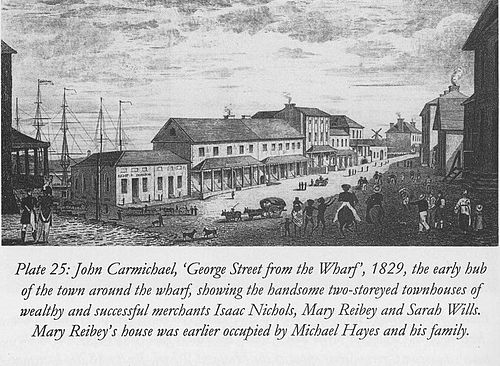- Mary Reibey
-
 Miniature of Mary around 1835 i.e. about 58 years old. It is the only known portrait of Reibey.[1]
Miniature of Mary around 1835 i.e. about 58 years old. It is the only known portrait of Reibey.[1]
Mary Reibey (12 May 1777 – 30 May 1855) was an Englishwoman who was transported to Australia as a convict but went on to become a successful businesswoman in Sydney.
Contents
Early life
Mary Reibey, baptised Molly Haydock, was born on 12 May 1777 in Bury, Lancashire, England. Following the death of her parents, she was reared by a grandmother and sent into service. She ran away, and was arrested for horse stealing in August 1791.[2] At the time, she was disguised as a man and was going under the name of James Burrow. [3] Sentenced to seven years' transportation, she arrived in Sydney, Australia, on the Royal Admiral in October 1792.
Life and career in Australia
On 7 September 1794, 17-year-old Mary married Thomas Reibey, after he had proposed to her several times; she finally agreed to marry the junior officer on the store ship Britannia. Reibey also used the surnames Raiby, Reiby and Reibey interchangeably, but the family adopted the spelling Reibey in later years. Thomas Reibey was granted land on the Hawkesbury River, where he and Mary lived and farmed following their marriage. They built a farmhouse called Reibycroft, which is now listed on the Register of the National Estate.[4] Thomas Raby commenced a cargo business along the Hawkesbury River to Sydney, and later moved to Sydney.
Thomas Reibey's business undertakings prospered, enabling him in 1804 to build a substantial stone residence on a further grant of land near Macquarie Place. He acquired several farms on the Hawkesbury River, and traded in coal, cedar, furs and skins. He entered into a partnership with Edward Wills, and trading activities were extended to Bass Strait, the Pacific Islands and, from 1809, to China and India.
When Thomas Reibey died on 5 April 1811, Mary assumed sole responsibility for the care of seven children and the control of numerous business enterprises. She was no stranger to this task, having managed her husband's affairs during his frequent absences from Sydney.
Now a woman of considerable wealth by her husband's businesses, Mary Reibey continued to expand her business interests. In 1812 she opened a new warehouse in George Street and in 1817 extended her shipping operations with the purchase of further vessels. By 1828, when she gradually retired from active involvement in commerce, she had acquired extensive property holdings in the city.
In the emancipist society of New South Wales, she gained respect for her charitable works and her interest in the church and education. She was appointed one of the Governors of the Free Grammar School in 1825.
Reibey built a cottage in the suburb of Hunters Hill circa 1836, where she lived for some time. The cottage, situated on the shores of the Lane Cove River, was later acquired by the Joubert brothers, who enlarged it. It is now known as Fig Tree House and is listed on the Register of the National Estate.[5]
On her retirement, she built a house at Newtown, Sydney, where she lived until her death on 30 May 1855. Five of her seven children had predeceased her.
An enterprising and determined person of strong personality, during her lifetime Mary Reibey earned a reputation as an astute and successful business woman in the colony of New South Wales. She is featured on the obverse of Australian twenty-dollar notes printed since 1994[1].
Notes
- ^ a b "The Australian $20 Banknote". Reserve Bank of Australia. http://www.rba.gov.au/banknotes/types/twenty-dollar.html. Retrieved 27 July 2011.
- ^ Daily Telegraph, 12 May 2009, p.37
- ^ Reibey, Mary (1777 - 1855) Biographical Entry - Australian Dictionary of Biography Online
- ^ The Heritage of Australia, Macmillan Company, 1981, p.2/22
- ^ The Heritage of Australia, p.2/28
References
- Irvine, N, Mary Reibey: Molly Incognito, Library of Australian History, 1982.
- Irvine, N (ed), Dear Cousin: The Reibey Letters, Hale & Iremonger, 1995.
- Pike, D (ed), Australian
Categories:- 1777 births
- 1855 deaths
- Australian businesspeople
- Australian philanthropists
- Convicts transported to Australia
Wikimedia Foundation. 2010.

